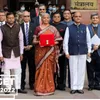Budget 2022 is a truly inclusive push towards taking economy to 9.2 pc GDP growth
This year's Budget is focused majorly on infrastructure, digitisation, real estate, MSMEs, and upskilling to fill the demand-supply gap in jobs.
This year's Budget has been aimed at boosting the economy. A very positive budget, its focus is on the overall economic growth as the government targets GDP of 9.2 percent. The biggest fear amongst all industries and businesses was the fear of inflation, but the expected GDP and boosting economic growth will help to cut down the fear of increasing prices.
Also, the 35 percent hike in capital expenditure is a very big move towards upbringing the economy which will help in cutting down the fear of rising inflation in the country.
The key announcements catering to various other sectors followed by:-
Digitisation
Digitisation has been given a huge push this time, which is going to benefit multiple sectors in the country. Many businesses and startups will see the benefits of as the government has talked about the digitisation of agriculture by using drones for crop farming and land to promote digitisation in infrastructure.
Even in the fintech sector, the government has talked about a huge digital push that is massively going to benefit the finance and fintech segments because the country, in any case, is moving towards digital payments.
To encourage digital payments, the government has scheduled commercial banks to set up 75 banks in 75 districts. This is also going to help India to put on the global scale of the digital economy. The government’s digital platform, Gati Shakti, will also pull forward the economy and will lead to more jobs and opportunities for the youth.
Up-skilling
The government has also announced DESH-Stack E-portal which will give a huge boost to employment because the portal is focused on empowering citizens to skill, re-skill or upskill through online training, which can place India as a global hub for talent. As the last two years have seen a huge demand-supply gap in jobs, upskilling the youth is the need of the hour to meet the employee demand-supply gap.
The government’s announcement on the national skill qualification framework will be aligned with dynamic industry needs, for which, 750 virtual labs and 75 skilling e-labs will be set up for simulated learning.
Additionally, 60 lakh job provisions in the country is a very big step towards boosting employment and will pull forward the economy in India because there is a need for job creation. As we all know, because of the pandemic, people have been pushed back, lost jobs, and are unable to find jobs with desired salaries.
Support to MSMEs
To support the MSMEs, the government has announced Rs 6,000-crore programme to be rolled out over the next five years. This is going to give a huge push to the MSME sector, which contributes to around 15-18 percent of India’s GDP.
It’s a very inclusive budget this time for financial inclusion and digital inclusion and buildup towards a better economy is witnessed in this budget.
This year's Budget is focused majorly on infrastructure, digitisation, real estate, MSMEs, and upskilling to fill the demand-supply gap in jobs.
The PLI scheme across 14 sectors, including IT hardware manufacturing, has the potential to generate at least 60 lakh new job opportunities in covering key sectors like pharmaceuticals, medical devices, large-scale electronics manufacturing, food products, solar EV modules, automobiles/auto components, ACC battery, and textile products among others.
Edited by Kanishk Singh
(Disclaimer: The views and opinions expressed in this article are those of the author and do not necessarily reflect the views of YourStory.)








